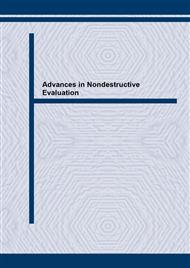[1]
Kurita, M., X-Ray Stress Measurement by the Gaussian Curve Method, Current Japanese Materials Research, Vol. 10 (1993), pp.135-151.
Google Scholar
[2]
Kurita, M., A Statistical Analysis of X-Ray Stress Measurement by the Gaussian Curve-Fitting Method, Journal of Testing and Evaluation, Vol. 9, No. 5 (1981), pp.285-291.
Google Scholar
[3]
Kurita, M., A Basic Theory for X-Ray Stress Measurement by Gaussian Curve Method, Journal of JSNDI, Vol. 39, No. 3, (1990), pp.243-249. (in Japanese).
Google Scholar
[4]
Kurita, M., Simplified Equations for Rapidly Calculating a Parabola and a Gaussian Function by the Least-Squares Method with Engineering Applications, Transactions of JSME (A), Vol. 54, No. 508 (1988), pp.2176-2180. (in Japanese).
DOI: 10.1299/kikaia.54.2176
Google Scholar
[5]
Kurita, M., Simplified Equations for Peak Position and for its Standard Deviation in X-Ray Stress Measurement, Journal of Testing and Evaluation, Vol. 9, No. 2 (1981), pp.133-140.
DOI: 10.1520/jte11654j
Google Scholar
[6]
Kurita, M., Statistical Analysis of X-Ray Residual Stress Measurement Using the Half-Width Method, Journal of Testing and Evaluation, Vol. 10, No. 2 (1982), pp.38-46.
DOI: 10.1520/jte10231j
Google Scholar
[7]
Kurita, M., Amano, J., Sakamoto, I., Statistical Analysis of X-Ray Stress Measurement by Centroid Method, Journal of JSMS, Vol. 31, No. 345 (1982), pp.609-615. (in Japanese).
Google Scholar
[8]
Hilley, M.E. ed, Residual Stress Measurement by X-Ray Diffraction, SAE J784a (1980), SAE.
Google Scholar
[9]
Kurita, M., A New Method for Evaluating X-Ray Diffraction Peak Broadening with Engineering Applications, Advances in X-Ray Analysis, Vol. 31 (1988), pp.277-286.
DOI: 10.1007/978-1-4613-1035-8_30
Google Scholar


